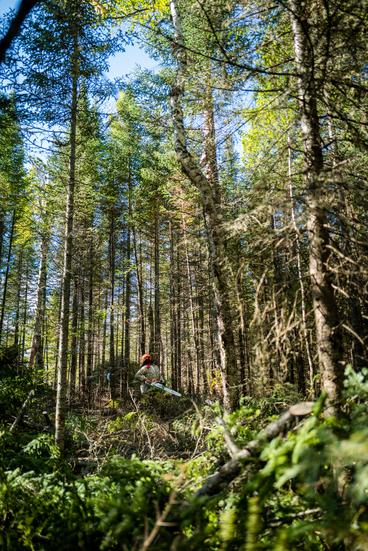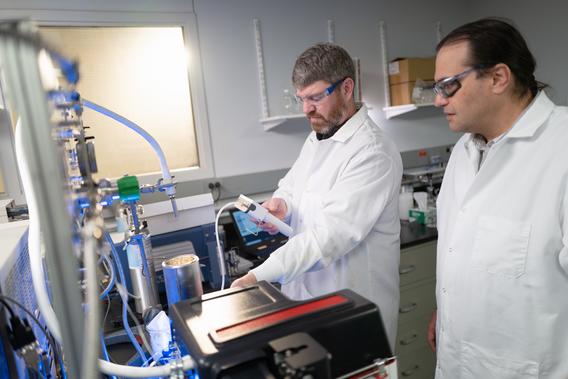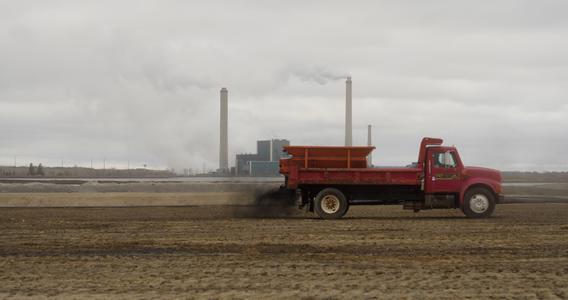Photos by Alexander Messenger / Video by David Cowardin
Wildfires are a real and present threat nationally, but also in Minnesota’s northern tree-dense landscapes, like the Superior National Forest. And a warming climate, accompanied by more frequent drought, exacerbates conditions.
But there’s one tree species in the forest that especially adds to the problem – balsam fir. Young fir trees are called “ladder fuel” by the U.S. Forest Service and National Park Service crew that manage wildfire danger.

“Balsam fir are a natural and ecologically valuable tree in our forests, but they make up a dense understory that can move a fire quickly up into the canopy where it spreads faster,” said Patrick Johnson, Superior National Forest fire management officer. “The best way to mitigate wildfires that threaten people and property is by selectively removing that species.”
And so they do. Skilled crews, in helmets and chaps, wield whirring chainsaws to bring down young balsam fir trees smaller than five inches in diameter. The effort is time consuming and expensive. And because there are no markets for this softwood resource, the Park Service has no other option but to pile it up and let it rot or burn the wood. Both options release carbon dioxide into the atmosphere.
Adding to the problem, the spruce budworm cycles through the fir stands, munching buds and killing the trees, making them even more fire vulnerable.
“Right now, there are about 300,000 acres of balsam fir defoliated by spruce budworm in the Superior National Forest and it’s moving east,” said Johnson. “Over the next five years, we expect that to grow, which will be quite detrimental to our fire situation, unfortunately.”
Sequestering Solution
With funding from the U.S. Forest Service Wood Innovation Grant Program, NRRI researchers are developing the hidden value in that piled-up wood resource. Carbon offset credits are generated when the downed fir is converted into an engineered biocarbon product – broadly referred to as biochar – and that value can be reinvested in improved wildfire management. Carbon credits are generated from net-negative carbon projects and purchased by industries that cannot meet carbon emission goals.
The biochar product also has value as a marketable product for a variety of uses.

“This is an exciting moment for biochar in that there’s a lot of interest, with big industry backing carbon sequestration and the bioeconomy,” said Brian Barry, NRRI chemist and project lead. “This project will demonstrate how biochar can be deployed in hopes that we can help grow this industry.”
Biocarbon is charred biomass, basically like a charcoal. Once transformed, the carbon is locked in, and those carbon credits can be sold in an online marketplace. One cubic yard of biochar represents about 0.7 tons of CO2 equivalents, or 0.7 of a carbon offset credit. Market prices fluctuate with supply and demand, but carbon credits currently range between $40 - $80 per metric ton, according to 8BillionTrees.com.
The charring process, in a no- or low-oxygen kiln, produces highly porous granules which are excellent materials for various water treatment and soil amendment applications.
“As a material, biochar has a lot of beneficial environmental qualities – from improving the microbial health of soils for more productive crops to removing contaminants from stormwater runoff,” Barry explained. “Minnesota is poised to be a biochar leader. We’re anticipating large-scale production facilities to be built in the next few years.”
Old is New
Charring biomass to improve soils is an ancient practice. Pre-Columbian civilizations living on sandy soils in Mesoamerica enhanced their agricultural productivity with a method of “slash and char” which created pockets of “terra preta,” Portuguese for “black earth.” They cut crop remains and added other waste, then ignited and buried the biomass to smolder, which eventually produced char.
But even though it’s an ancient method, moving today’s biochar industry forward will take a lot of science and engineering.
Barry and his team are characterizing biochars made under varying conditions to impart specific properties for specific applications. The kiln temperature, time in the kiln, and biomass source all impact the biochar’s performance properties.
In Action

In partnership with energy provider Minnesota Power, NRRI is applying charred balsam fir to a capped coal ash landfill at the Boswell Energy Center in Cohassett, Minn. The goal is to improve the soil so that native grasses can revegetate this space for new uses.
“Particularly for coal ash landfills, one of the challenges for revegetation is making sure the cover has decent water holding capacity,” Barry said. “And one of the key features of biochar is its porosity, allowing high water holding capacity.”
In the late fall of 2022, twelve super sacks of balsam fir biochar – about three tons – were applied to the ash landfill. This small-scale demonstration effort represents roughly eight carbon offset credits, and the removal of around 23 cords of wildfire fuel from the forest.
“If we had more financial resources, we would double or triple our capacity to remove balsam fir from the Superior National Forest,” said Forester Johnson. “Biochar seems like a great solution where we can provide a product that’s worthwhile and find markets for it, that would be a great benefit to the public.”
The U.S. Forest Service grant funded half of the $375,000 budget for this demonstration project, the rest was matched by Minnesota Power and NRRI.
Next Steps
And while biochar has attracted quite a buzz, building market demand will require ongoing research to develop and demonstrate uses beyond agricultural applications.
NRRI researchers will continue to seek partnerships with industry and government agencies to advance materials that lock away atmospheric carbon while offering enhanced performance and higher value.
